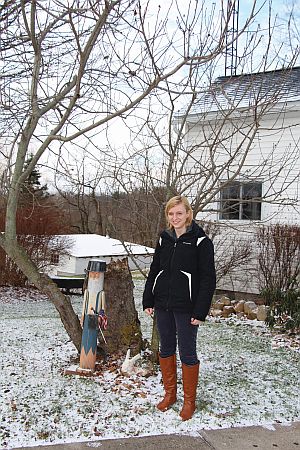Johnny Appleseed Has More In Common With You Than Just Apples
 In my experience, most fruit growers are history buffs. I think they would appreciate knowing how apples found their way how apples found their way to this country, were propagated from coast to coast, and how vital they were in the early stages of this country.
In my experience, most fruit growers are history buffs. I think they would appreciate knowing how apples found their way how apples found their way to this country, were propagated from coast to coast, and how vital they were in the early stages of this country.
Over the Thanksgiving weekend, I caught up on a piece of history. You see, the last living tree believed to have been planted by Johnny Appleseed is about 10 miles from my parents’ house. Located in Nova, OH, this tree endured a lifetime of Ohio winters and Ohio tornadoes until a few years ago when the main trunk collapsed. But shoots emerged from the trunk and the legend of this nearly 200-year-old tree continues.

I posed for a photo with the tree in Nova, OH. (Photo credit: Regina Herrick)
The farm, now owned by Phyllis and Richard Algeo, has been in the Harvey-Algeo family for hundreds of years. In fact, the ninth generation is living on this farm! John Chapman, otherwise known as Johnny Appleseed, would stay at the Harvey homestead as he passed through the area. He slept in a shed on the farm, since he rarely stayed in homes.
There is debate as to whether or not this tree, a Rambo variety, is one that Johnny Appleseed himself would have planted. But, debating the authenticity of this tree isn’t the purpose of this column.
You see, history and lore are invariably interwoven in the tapestry of apple growing and in the history of this country.
There are lessons to be learned from Johnny Appleseed. Here’s a few that I gleaned from my research:
Plant With A Purpose
Although most people assume Johnny Appleseed planted trees randomly in the Ohio, Indiana, and Illinois region for the good of the Earth, he carefully selected land to plant his orchards and built fences to protect the new plantings.
The varieties he planted were instrumental in the drinking staple of the time, hard cider. On the frontier, hard cider was a safer drinking choice than water.
Tend To Your Plantings
Johnny Appleseed returned to his orchards to check on them from time to time.
Plant What You Can Make A Profit With
Apple growers are no stranger to estimating the risk/reward benefit of putting a tree in the ground.
Johnny Appleseed was a true apple grower. Planting the orchards as he did, he would sell the established land to incoming frontiersmen. These orchards served as a land claim in the newly forming frontier.
I read that frontiersmen seeking to establish a homestead were required to plant 50 apple trees and 20 peach trees in three years in order to make this settlement official.
Chapman owned 1,200 acres of land at the time of his death, according to Biography.com.
Know The Land
Early grafted varieties from Europe proved difficult to establish on the different soils in the colonies. Chapman preferred to plant his trees with seeds, based on his religious beliefs. This also allowed the plantings to take root in various soils (and seeds were a lot easier to transport in the long run).
It is believed that John Chapman planted approximately 12 to 20 bushels of apple seeds, with an estimated 330,000 seeds per bushel. He planted apple orchards every year for 45 years.
It’s an impressive feat for a man who was believed to travel the frontier with no shoes and wearing a pot on his head.
Lore and tall tales aside, John Chapman was an apple grower to the core. And for this reason his feats are worth noting.










